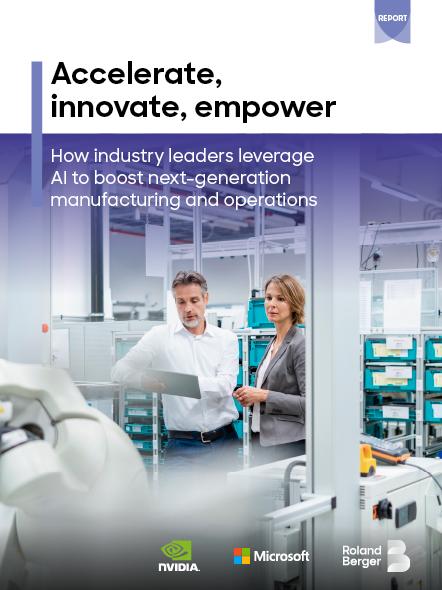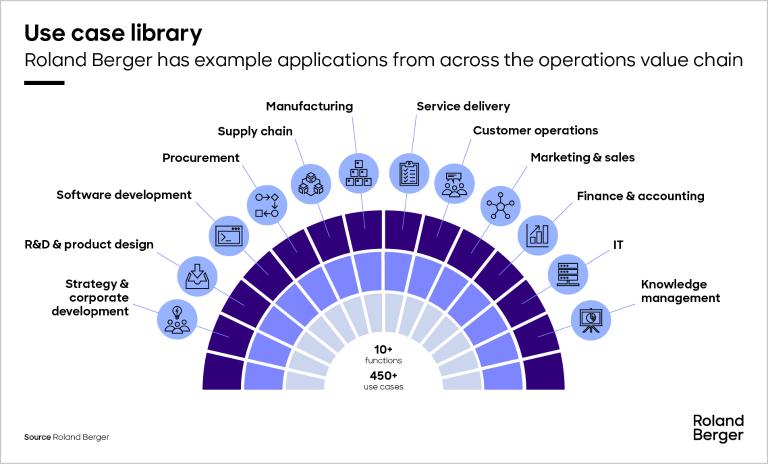In this episode, Julia Duwe and Pieter Niehues debate the transformative role Generative Artificial Intelligence is going to play in operations throughout the next 2-3 year.


AI in operations: The key success factors
Seven proven principles to boost adoption and increase value-add
Artificial intelligence (AI) is set to transform industrial operations. The technology promises huge improvements across the value chain, boosting competitiveness, enhancing sustainability and reducing workforce shortages. It is expected to deliver up to 60% reduction in product development times, for example. However, industry is struggling to keep up with the pace of innovation and bringing promising solutions to value-adding use. As a result, only one in six manufacturers have so far successfully incorporated AI into their operations, according to World Economic Forum data. So how can businesses, already faced with significant market headwinds, successfully adopt AI in operations?

To fully leverage AI for operations, industrial companies must define a holistic transformation ‘flight path’. Roland Berger, Microsoft and NVIDIA’s report ‘AI in operations: Accelerate, innovate, empower’ plots a way forward, outlining best practice solutions to pursue and the necessary enablers to create tangible impact. It offers examples of proven use cases taken from entrants of the Microsoft Intelligent Manufacturing Awards presented by Roland Berger and Microsoft and summarizes key success factors and details of how Roland Berger and Microsoft can support companies.
"AI has become a transformative force, offering unparalleled opportunities to optimize processes, enhance decision-making and drive efficiencies across the value chain."
Navigating the flight path towards value-adding AI in operations
Proving business value, missing infrastructure to support use cases and a shortage of skilled AI talent are the primary challenges to the successful adoption of AI in operations. To optimize the development and execution of the flight path, businesses must therefore consider three key strategic questions:
What are the value levers? Before thinking about technology, identify pressing problems and value pockets. Without considering the implications for AI, clarify the strategic optimization opportunities in operations.
How do I leverage the technology? As a second step, mirror the identified opportunities with technological capabilities. What technology might bring value to my operations? Which use cases are worth pursuing, not as an end in themselves, but to strategically improve my processes? Which technologies are at hand and can be leveraged, which need to be built up?
What is my roadmap? Finally, players need to develop a roadmap, defining the steps involved in building appropriate capabilities, quantifying benefits and creating a tangible pathway toward value creation.
Key success factors
Such questions can seem daunting. But over the past five years, the MIMA application rounds helped to build a comprehensive picture of what digitalization can achieve in operations. This has enabled us to identify seven key factors common to successful adopters of digital solutions, and in particular AI in operations. All should be considered by companies when developing their flight path toward impactful digitalization.
- Develop a clear AI roadmap with explicit objectives, including executive sponsorship and a clear organizational change process, to match capabilities and targets and create maximum value-add
- Determine the technical foundation and ensure data accessibility, keeping data secure while still enabling rapid scaling of digital solutions
- Embrace modular platforms for their own and client solutions to simplify scaling, adaptation to future products and maintenance
- Leverage off-the-shelf technology components to benefit from established technology components and enable a ‘fail fast’ approach while minimizing risk
- Democratize digitalization, enabling domain specialists across hierarchy levels to turn domain knowledge into intelligent solutions
- Empower workforces with AI-based solutions, allowing them to focus their capacities and overcome labor shortages
- Exploit AI’s potential to disrupt value creation by using AI-generated insights to improve core offering, maintain installed base and create new products.
"Successful AI adoption requires a clear strategy, transparency on existing and required capabilities, and a laser-like focus on the targeted added value."
In the report, we present commercial examples of each from among MIMA entrants. For example, the carmaker Mercedes-Benz created its ‘MO360’ platform to decouple data storage and usage, with all contained operations data stored in a structured manner and accessible via a self-service marketplace. This allows swift use-case realization for users across all functions, from shopfloor to engineering. A 20% operations efficiency increase is expected in 2025.
Machine tool producer Trumpf optimizes the use of scarce tooling machine operators by geographically detaching machine and operator. Its remote monitoring and control service allows machine specialists to oversee many geographically distributed machines. This has increased productivity and gained valuable machine data for analytics purposes.
In addition to the success factors derived from the MIMA case studies, the report offers insights into the future of AI in operations through the lens of the full-stack AI pioneer NVIDIA. It outlines key future trends, highlights the increasing significance of generative AI, and provides tips for the successful implementation of AI tools.
In the final section of the report, we outline Roland Berger’s support solutions. We offer a multitude of AI-focused tools (RB’s N3XT, Readiness Assessment and CostIQ), expertise (a 200+ use case library) and approaches (RB’s rAIse framework) that can identify solutions, ensure smooth adoption and maximize their potential.
Register now to access the full study and explore strategies for successful AI adoption in operations.













